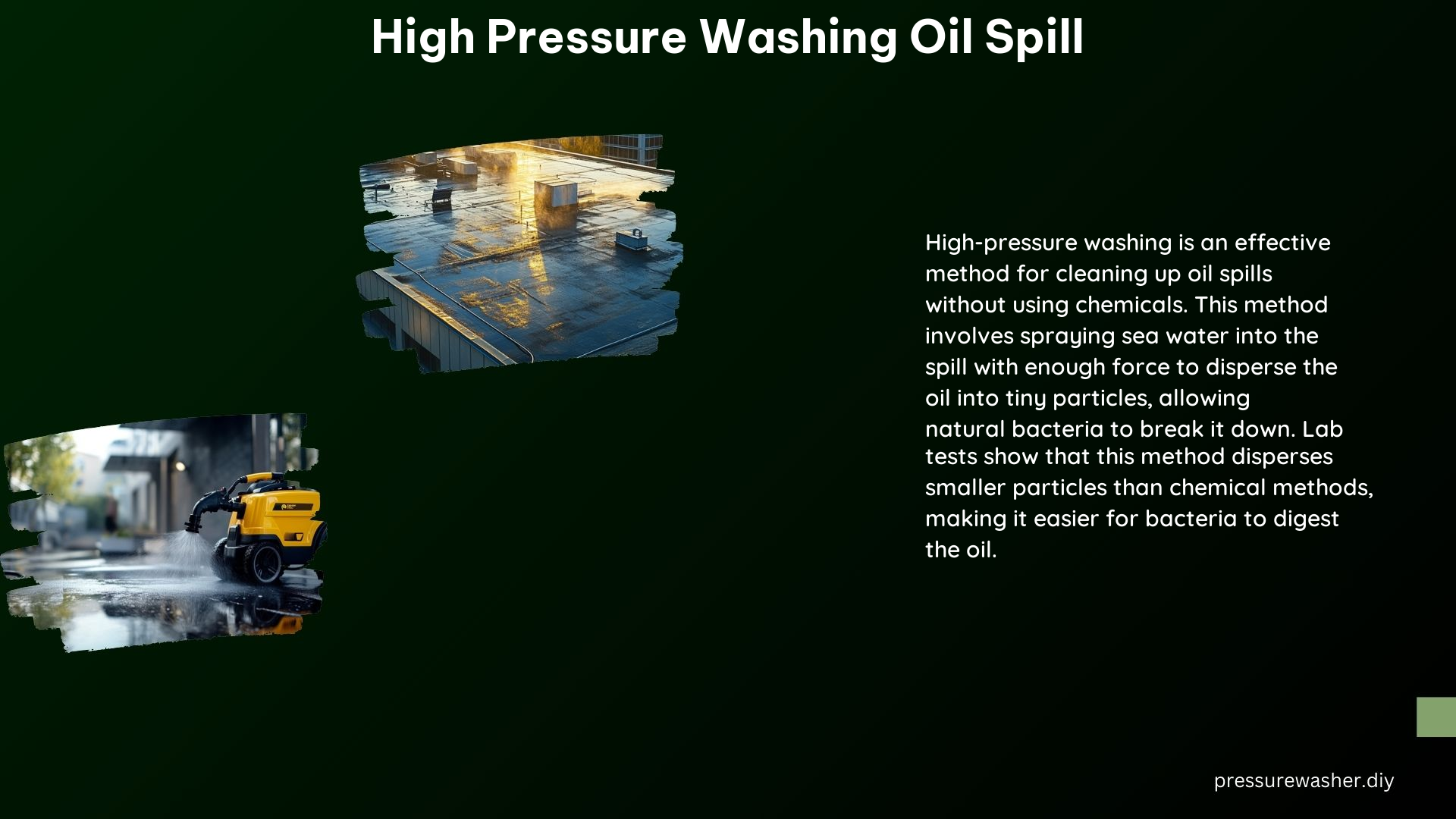High-pressure washing is a highly effective method for cleaning up oil spills by blasting away oily residue with hot water. This technique, when paired with a vacuum system, allows for the efficient capture and removal of the contamination, making it a valuable tool in the arsenal of oil spill response and remediation efforts.
Environmental Effects
Reduced Chemical Use
One of the primary advantages of high-pressure washing for oil spill cleanup is the reduced need for harsh chemicals, such as soaps, detergents, and dispersants. This makes it a more environmentally friendly option compared to traditional methods that rely heavily on chemical agents. By minimizing the use of these chemicals, high-pressure washing helps to mitigate the potential negative impacts on the surrounding ecosystem, reducing the risk of further environmental damage.
Effective Dispersal
The high-pressure wash effectively disperses the oil into smaller particles, making it easier for the natural bacteria present in the ocean to break down the oil. This natural biodegradation process is a crucial aspect of oil spill remediation, as it helps to accelerate the removal of the contaminants from the environment.
Impact on Shorelines and Water Surfaces

Rocky and Stony-Gravelly Shores
High-pressure, hot water hosing techniques have proven to be particularly effective in reducing the impact of oil spills on rocky and stony-gravelly shorelines. These types of shores can be challenging to clean using traditional methods, but the high-pressure wash is able to dislodge and remove the oily residue, helping to restore the natural environment.
Water Dispersal
Similar to the dispersal of oil on land, the high-pressure wash also helps to break down the oil on water surfaces into smaller particles. This allows for easier and more efficient breakdown by the naturally occurring bacteria in the ocean, further enhancing the environmental benefits of this cleanup method.
Risks and Considerations
EPA Regulations
It is crucial to ensure that high-pressure washing for oil spill cleanup is conducted in full compliance with EPA regulations. Proper disposal of the contaminated runoff is essential to avoid fines, lawsuits, and further environmental damage. Adhering to these regulations is a critical aspect of responsible and effective oil spill remediation.
Hazmat Protocols
Following hazmat protocols and reporting the spill to local authorities is essential to ensure the proper handling and disposal of all contaminated materials. This includes personal protective equipment (PPE), such as specialized suits, gloves, and respirators, as well as the safe transport and disposal of the recovered oil and other hazardous waste.
Technical Specifications
Hydro Tek Equipment
Hydro Tek, a leading manufacturer of high-pressure cleaning equipment, offers mobile hot water pressure washers and industrial vacuum systems specifically designed for oil spill cleanup. These systems are capable of recovering up to 25 gallons of oil per minute and are constructed with durable stainless steel and industrial-grade components to withstand the rigors of oil spill cleanup operations.
ChemFree Technology
ChemFree, a patented technology, utilizes high-pressure seawater to disperse oil into smaller particles, allowing for natural breakdown by ocean bacteria. This method has shown promising results in laboratory tests and is currently being developed for full-scale testing and implementation in real-world oil spill scenarios.
DIY Considerations
Professional Expertise
While high-pressure washing can be an effective DIY solution for small-scale oil spills, it is important to note that oil spill cleanup requires specialized equipment and expertise. It is strongly recommended to hire professional oil spill response teams who are equipped with the necessary tools, training, and experience to handle the job safely and effectively.
Proper Disposal
Ensuring the proper disposal of all contaminated materials, in accordance with hazmat protocols and EPA regulations, is crucial. Improper handling or disposal of these hazardous materials can lead to further environmental damage and legal consequences.
References:
1. https://www.hydrotek.us/applications/oil-spill-cleanup/
2. https://www.sciencedirect.com/science/article/pii/0141113683900090
3. https://www.sintef.no/en/latest-news/2015/high-pressure-wash-cleans-up-oil-spills/
4. https://norwegianscitechnews.com/2015/09/high-pressure-wash-cleans-up-oil-spills/
5. https://www.reddit.com/r/pressurewashing/comments/w5j7vi/oil_spill/
